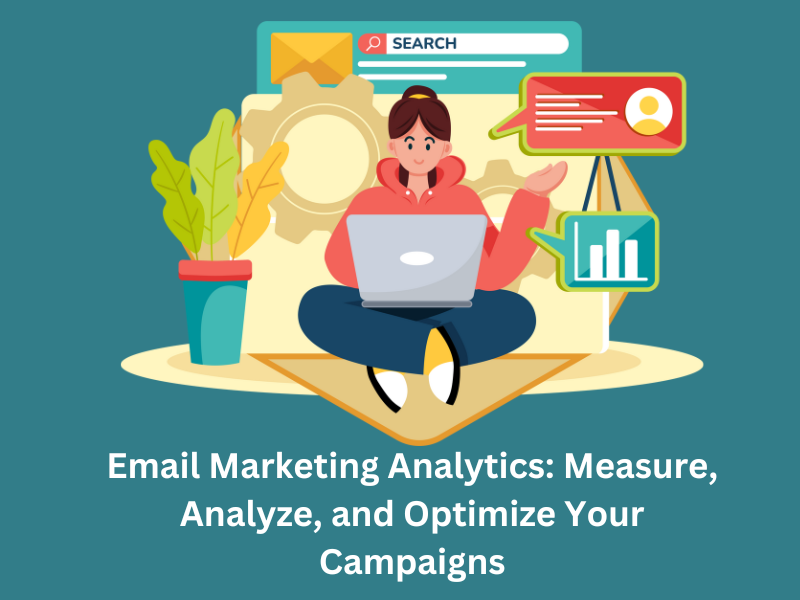Email marketing is one of the most powerful tools available to brands today, driving engagement, boosting conversions, and fostering customer loyalty. However, one of the biggest challenges marketers face is dealing with inactive subscribers—those who once showed interest in your brand but have since stopped engaging with your emails.
These dormant contacts can significantly impact your email marketing performance, dragging down open rates and click-through rates, and ultimately costing your brand valuable resources. In fact, studies show that as much as 60% of email lists are made up of inactive subscribers. So, how can you reignite that initial spark and bring these subscribers back to life?
Enter the re-engagement campaign—a strategic, targeted effort designed to win back the interest of inactive subscribers. Not only do these campaigns have the potential to recover lost customers, but they also help maintain a healthy and responsive email list. By understanding why subscribers become inactive and employing a variety of proven tactics, you can effectively revive your email list and boost your overall marketing success.
In this article, we’ll dive deep into the strategies for creating compelling re-engagement campaigns, explore the benefits of revitalizing inactive subscribers, and outline best practices to ensure your efforts are both compliant and effective. Whether you’re looking to improve your email deliverability or simply want to reconnect with past subscribers, these strategies will help you win back the hearts—and clicks—of your audience.
Understanding Inactive Subscribers
Before diving into re-engagement strategies, it’s essential to understand who inactive subscribers are and why they’ve stopped engaging with your emails. This understanding will allow you to tailor your re-engagement campaigns to address their specific needs and interests, increasing your chances of winning them back.
Definition of Inactive Subscribers
Inactive subscribers are individuals who were once engaged with your emails but have since stopped opening, clicking, or interacting with them. The definition of “inactive” can vary depending on your business and email marketing practices, but it generally refers to subscribers who haven’t engaged with your emails for a set period—typically six months to a year.

Common Reasons for Subscriber Disengagement
Several factors can lead subscribers to become inactive. Understanding these reasons is key to crafting re-engagement strategies that resonate with them:
- Content Irrelevance: One of the primary reasons subscribers stop engaging is because they find the content irrelevant or uninteresting. This could be due to a disconnect between their expectations when they signed up and the actual content they receive.
- Email Frequency: Sending too many emails can overwhelm subscribers, leading to disengagement. On the flip side, sending too few emails might cause your audience to forget about your brand.
- Lack of Personalization: Subscribers are more likely to ignore emails that feel generic or impersonal. They want content that speaks directly to their interests and needs.
- Life Changes: Sometimes, subscribers’ interests or needs change due to personal or professional shifts, causing them to lose interest in your content.
- Poor Email Design or Functionality: Emails that are difficult to read on mobile devices, have broken links, or are otherwise challenging to interact with can lead to frustration and disengagement.
The Cost of Keeping Inactive Subscribers on Your List
Maintaining a high number of inactive subscribers isn’t just an issue of vanity metrics; it has real, tangible costs for your email marketing efforts:
- Lower Engagement Rates: Inactive subscribers decrease your open and click-through rates, which can negatively affect your sender reputation and deliverability. Email providers like Gmail and Outlook may filter your emails into the spam folder if they detect low engagement.
- Increased Costs: Many email service providers charge based on the number of subscribers on your list. Keeping inactive subscribers increases your costs without providing any return on investment.
- Misleading Data: Inactive subscribers can skew your analytics, making it difficult to accurately measure the effectiveness of your email campaigns and understand your audience’s preferences.
By identifying and understanding your inactive subscribers, you can begin to formulate targeted re-engagement strategies that address their reasons for disengagement and reignite their interest in your brand.
Benefits of Re-Engagement Campaigns
Re-engagement campaigns are not just a remedy for an underperforming email list; they are a strategic tool that offers numerous benefits to brands looking to enhance their email marketing efforts. By focusing on reactivating inactive subscribers, you can breathe new life into your campaigns and unlock a wealth of opportunities.

Why Re-Engagement Campaigns Are Crucial for Maintaining a Healthy Email List
Inactive subscribers may seem like a burden on your email list, but they also represent a unique opportunity. These are individuals who once showed interest in your brand, meaning the potential for re-engagement is already there. Rather than writing them off, a well-crafted re-engagement campaign allows you to tap into that latent interest and bring these subscribers back into the fold.
Benefits of Re-Engaging Inactive Subscribers
- Improved Deliverability: One of the most immediate benefits of re-engagement campaigns is improved email deliverability. Email providers often use engagement metrics, such as open rates and click-through rates, to determine the relevance of your emails. By removing or re-engaging inactive subscribers, you improve these metrics, which can increase the likelihood of your emails landing in the primary inbox rather than the spam folder.
- Higher Open and Click-Through Rates: Reactivated subscribers are more likely to open and engage with your emails, boosting your overall open and click-through rates. This increased engagement can have a positive ripple effect, leading to better performance across all your email campaigns.
- Reduced Churn: By re-engaging inactive subscribers, you can reduce the rate at which people unsubscribe from your list. Subscribers who feel reconnected with your brand are more likely to stay engaged, reducing churn and fostering long-term loyalty.
- Cost Efficiency: Keeping a clean and active subscriber list can save you money. Most email service providers charge based on the size of your list, so by focusing on re-engaging or removing inactive subscribers, you can reduce costs and ensure you’re only paying for active, engaged contacts.
Long-Term Advantages of a Clean and Active Subscriber List
A well-maintained email list isn’t just about short-term gains; it also sets the foundation for long-term success. When your list is full of engaged subscribers, you’re better positioned to:
- Increase Revenue: Engaged subscribers are more likely to convert, whether that means making a purchase, signing up for a webinar, or taking another action that drives revenue.
- Build Stronger Relationships: Consistently engaging your audience fosters a deeper connection with your brand. When subscribers feel valued and understood, they’re more likely to remain loyal customers.
- Enhance Brand Reputation: A clean, engaged email list signals to email providers that your brand is reputable and trustworthy, which can improve your overall email deliverability and help you maintain a strong brand image.
By understanding the benefits of re-engagement campaigns, you can appreciate their value in maintaining a healthy email list and driving long-term success for your brand.
Key Strategies for Re-Engagement Campaigns
Winning back inactive subscribers requires a thoughtful approach, combining creativity with data-driven insights to craft campaigns that resonate. Here are some effective strategies to help you re-engage your audience and revitalize your email list:

A. Segmentation and Targeting
The foundation of any successful re-engagement campaign is segmentation. Not all inactive subscribers are the same; they may have different reasons for becoming disengaged and varying levels of interest in your brand. By segmenting your inactive subscribers based on behavior, demographics, or purchase history, you can create more personalized and relevant campaigns.
- Identifying Inactive Subscribers: Start by defining what “inactive” means for your brand. This could be subscribers who haven’t opened an email in the last six months or those who haven’t clicked through in a year. Use your email marketing platform’s analytics tools to identify these segments.
- Targeting Different Segments: Once you’ve identified inactive subscribers, create different segments based on their inactivity levels or previous engagement patterns. Tailor your re-engagement emails to these specific segments to address their unique reasons for disengagement.
B. Personalized Content and Offers
Personalization is key to catching the attention of inactive subscribers. By delivering content that is relevant and tailored to their preferences, you can increase the likelihood of re-engagement.
- Creating Compelling Content: Use the data you have on subscribers to create personalized content. This could include product recommendations based on past purchases, content related to their browsing history, or updates on topics they’ve shown interest in before.
- Exclusive Discounts and Incentives: Offering special discounts or incentives can be a powerful motivator. Highlight these offers in your subject line and email content to entice inactive subscribers to re-engage. For example, “We Miss You! Enjoy 20% Off Your Next Purchase.”
C. Re-Introduction Emails
Sometimes, all it takes to win back inactive subscribers is a friendly reminder of why they signed up in the first place. Re-introduction emails are designed to reconnect with subscribers by reminding them of the value your brand provides.
- “We Miss You” or “Come Back” Emails: Craft a series of emails with messages like “We Miss You!” or “We Noticed You Haven’t Been Around.” Use a warm and inviting tone to remind them of what they’re missing out on.
- Compelling Subject Lines and Messages: The subject line is the first thing subscribers see, so make it count. Use language that evokes curiosity or urgency, such as “Don’t Miss Out on Your Favorite Updates” or “Here’s What You’ve Been Missing.”
D. Survey and Feedback Requests
Engaging inactive subscribers with a request for feedback can provide valuable insights while showing that you value their opinion. This approach can also re-engage subscribers by making them feel heard and involved.
- Asking for Feedback: Send an email asking why they’ve become inactive and what you can do to improve. This can be as simple as a single-question survey or a more in-depth feedback form.
- Using Survey Results: Use the feedback you gather to make data-driven improvements to your email strategy. If subscribers cite irrelevant content as a reason for disengagement, consider updating your email segments or content strategy.
E. Frequency and Timing Adjustments
The frequency and timing of your emails can significantly impact engagement. Testing different frequencies and send times can help you find the sweet spot for re-engaging inactive subscribers.
- Testing Email Frequency: Experiment with sending emails more or less frequently to see what resonates with your audience. Some subscribers may respond better to a weekly digest, while others prefer less frequent updates.
- Optimizing Send Times: Analyze your email performance data to identify the best times to send re-engagement emails. This can vary based on your audience’s location, industry, and other factors, so testing different times is crucial.
By employing these strategies, you can create effective re-engagement campaigns that resonate with inactive subscribers, encouraging them to reconnect with your brand and become active participants once again.
Measuring the Success of Re-Engagement Campaigns
To ensure your re-engagement campaigns are effective and driving the desired results, it’s crucial to measure their success through detailed analysis and performance tracking. By monitoring key metrics and making data-driven decisions, you can optimize your strategies and improve overall engagement with your email list.

Key Performance Indicators (KPIs) to Track
When evaluating the success of your re-engagement campaigns, focus on the following key performance indicators (KPIs):
- Open Rates: This metric indicates the percentage of subscribers who open your emails. A rising open rate among inactive subscribers suggests that your subject lines and preview text are compelling enough to grab attention.
- Click-Through Rates (CTR): The click-through rate measures how many subscribers clicked on a link within your email. A higher CTR is a strong indicator that your content is engaging and that your call-to-action is effective.
- Reactivation Rates: This KPI tracks the number of previously inactive subscribers who engage with your emails after receiving a re-engagement campaign. A successful campaign will show an increase in reactivation rates.
- Unsubscribe Rates: While it might seem counterintuitive, monitoring unsubscribe rates is important. A high unsubscribe rate could indicate that your re-engagement emails are not resonating with subscribers or that they no longer find value in your content.
- Conversion Rates: If your goal is to encourage inactive subscribers to make a purchase or take a specific action, track the conversion rate of your re-engagement emails. This will help you understand how well your campaign drives the desired outcomes.
How to Analyze and Interpret Campaign Data
After collecting data on your KPIs, the next step is to analyze and interpret these metrics to gauge your campaign’s effectiveness. Here’s how to do it:
- Compare Metrics Over Time: Look at your KPIs over different time periods to identify trends. Are your open and click-through rates improving? Are more subscribers re-engaging with your content? Understanding these trends can help you determine whether your strategies are working.
- Segment-Based Analysis: Break down your data by different subscriber segments. For example, compare the engagement rates of subscribers who receive personalized content versus those who receive generic emails. This will help you identify which strategies are most effective for different groups.
- A/B Testing: Conduct A/B tests to experiment with different subject lines, content formats, or sending times. Analyze the results to determine which variations perform best and apply these insights to future campaigns.
Adjusting Strategies Based on Results
After analyzing your campaign data, use these insights to refine your re-engagement strategies:
- Optimize Email Content: If your click-through rates are low, consider revising your email content to make it more engaging or relevant to your audience. Incorporate personalized elements and compelling calls-to-action to encourage clicks.
- Reevaluate Targeting: If your open rates aren’t improving, reassess your segmentation strategy. Ensure you’re targeting the right subscribers with content that matches their interests and preferences.
- Test New Approaches: If certain strategies aren’t yielding the desired results, don’t be afraid to try something new. Experiment with different types of content, incentives, or email formats to see what resonates best with your audience.
By regularly measuring and analyzing the performance of your re-engagement campaigns, you can continuously optimize your approach, ensuring you effectively win back inactive subscribers and maintain a healthy, active email list.
Best Practices for Effective Re-Engagement Campaigns
Crafting a successful re-engagement campaign involves more than just sending a few emails to inactive subscribers. To truly win back your audience and maintain a healthy email list, you need to implement best practices that ensure your efforts are targeted, compliant, and continually optimized for maximum impact.

Keeping the Email List Clean
Maintaining a clean email list is vital for the success of your email marketing efforts. A clean list helps improve your deliverability rates and ensures that your emails reach engaged subscribers who are interested in your content.
- Regularly Remove Unresponsive Subscribers: Periodically clean your list by removing subscribers who remain inactive after your re-engagement efforts. This helps improve your overall engagement metrics and ensures that your emails are reaching people who want to hear from you.
- Implement a Sunset Policy: A sunset policy involves setting a defined period after which inactive subscribers are removed from your list if they do not re-engage. This keeps your email list fresh and focused on engaged contacts.
Consistently Updating and Optimizing Re-Engagement Strategies
Re-engagement campaigns are not a one-time effort but an ongoing process. Regularly reviewing and updating your strategies can help you stay relevant and effective in re-engaging subscribers.
- Monitor Trends and Subscriber Behavior: Stay updated on email marketing trends and subscriber behavior to adjust your strategies accordingly. This could involve changing the types of content you send, tweaking your sending frequency, or experimenting with new personalization techniques.
- Use Data to Drive Decisions: Leverage the data from your email campaigns to make informed decisions about future re-engagement efforts. Track which strategies are working and which aren’t, and adjust your approach based on these insights.
Ensuring Compliance with Email Marketing Laws and Regulations
Compliance is critical when it comes to email marketing. Ensuring that your re-engagement campaigns adhere to relevant laws and regulations protects your brand and fosters trust with your subscribers.
- Understand GDPR, CAN-SPAM, and Other Regulations: Familiarize yourself with the regulations that apply to your email marketing efforts. For example, the General Data Protection Regulation (GDPR) requires explicit consent from subscribers in the European Union, while the CAN-SPAM Act outlines specific requirements for sending commercial emails in the United States.
- Include Unsubscribe Options: Make it easy for subscribers to opt out of your emails if they no longer wish to receive them. Providing a clear and accessible unsubscribe link in every email is not only a legal requirement but also helps maintain a positive relationship with your audience.
Fostering Long-Term Engagement
Beyond re-engagement, it’s important to think about how you can maintain long-term engagement with your subscribers. Building strong relationships with your audience will reduce the number of inactive subscribers and enhance the overall effectiveness of your email marketing efforts.
- Deliver Value Consistently: Ensure that every email you send delivers value to your subscribers, whether through useful information, special offers, or exclusive content. When subscribers see value in your emails, they’re more likely to remain engaged.
- Encourage Interaction: Foster a two-way relationship by encouraging subscribers to interact with your emails. This could involve asking for feedback, prompting them to reply to your emails, or engaging with your brand on social media.
By following these best practices, you can create effective re-engagement campaigns that not only win back inactive subscribers but also enhance your overall email marketing strategy, leading to stronger relationships and better results.
Conclusion
Re-engagement campaigns are an essential part of any robust email marketing strategy. They offer a unique opportunity to win back inactive subscribers and breathe new life into your email list. By understanding why subscribers become inactive and employing targeted strategies—such as segmentation, personalized content, re-introduction emails, feedback requests, and adjusting email frequency—you can effectively reconnect with your audience and reignite their interest in your brand.
The benefits of re-engagement campaigns are clear: improved deliverability, higher open and click-through rates, reduced churn, and enhanced brand loyalty. Moreover, these campaigns help maintain a clean and active email list, which is crucial for accurate performance tracking and cost efficiency.
However, it’s important to remember that re-engagement is not a one-time effort but an ongoing process. Continuously monitor your email performance, optimize your strategies based on data-driven insights, and stay compliant with relevant laws and regulations to ensure long-term success. By fostering strong relationships and consistently delivering value to your subscribers, you can reduce the number of inactive contacts and build a thriving, engaged email community.
Now is the perfect time to take action. Start planning your re-engagement campaigns today, and watch as you transform dormant subscribers into active participants, boosting your email marketing success and driving growth for your brand.









